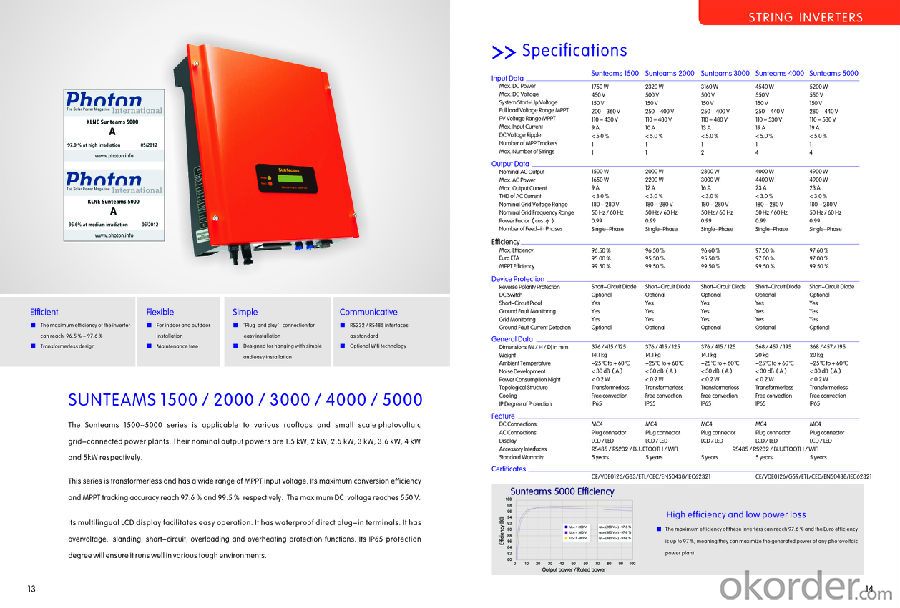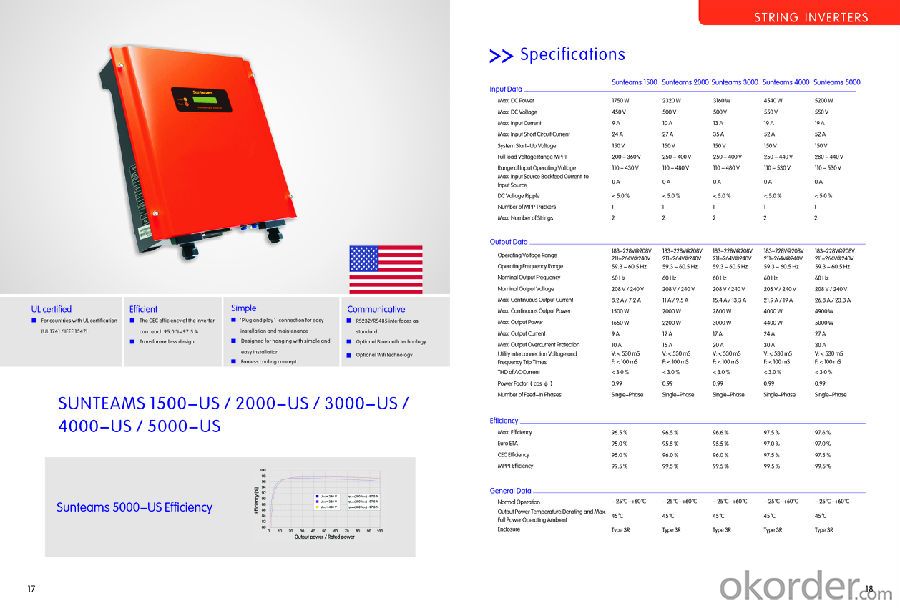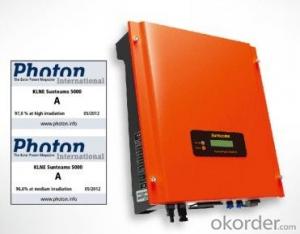Sunteams 3000 on grid inverter with WIFI US standard
- Loading Port:
- Shanghai
- Payment Terms:
- TT OR LC
- Min Order Qty:
- -
- Supply Capability:
- 10000 set/month
OKorder Service Pledge
Quality Product, Order Online Tracking, Timely Delivery
OKorder Financial Service
Credit Rating, Credit Services, Credit Purchasing
You Might Also Like
Sunteams 1500,2000,2500,3000,3600,4000,4600,5000
Sunteams US 1500,2000,2500,3000,3600,4000,4600,5000
1MPPT, single phase
IP 65
50Hz & 60 Hz
with Plug in wifi/ wifi box
with wire box/ without wire box
UL certified
■ For countries with UL certification (UL 1741 / IEEE 1547)
■ For countries with UL certification (UL 1741 / IEEE 1547)
Efficient
■ The CEC efficiency of the inverter can reach 95.0 %-97.5 %
■ Transformerless desi
■ The CEC efficiency of the inverter can reach 95.0 %-97.5 %
■ Transformerless desi
Simple
■ ‘Plug and play’connection for easy installation and maintenance
■ Designed for hanging with simple and easy installation
■ Fanless cooling concept
■ ‘Plug and play’connection for easy installation and maintenance
■ Designed for hanging with simple and easy installation
■ Fanless cooling concept
Communicative
■ RS232/RS485 interfaces as standard
■ Optional Bluetooth technology
■ RS232/RS485 interfaces as standard
■ Optional Bluetooth technology



- Q:Are there any government regulations or certifications for solar inverters?
- Yes, there are government regulations and certifications for solar inverters. In many countries, solar inverters must comply with specific standards and regulations set by government bodies. Additionally, various certifications such as International Electrotechnical Commission (IEC) standards, UL listing, and CE marking are commonly required to ensure the safety, performance, and interoperability of solar inverters.
- Q:How does a solar inverter protect against power surges?
- A solar inverter protects against power surges by incorporating surge protection devices and circuitry within its design. These devices are designed to detect and divert excessive voltage levels caused by power surges, thereby preventing damage to the inverter and the connected solar panels.
- Q:How does a solar inverter interact with a battery storage system?
- A solar inverter interacts with a battery storage system by converting the direct current (DC) electricity produced by solar panels into alternating current (AC) electricity, which is then used to charge the batteries. The inverter also ensures that the power from the batteries can be used to supply electricity to the loads when there is no sunlight or during a power outage. Additionally, the inverter manages the flow of electricity between the solar panels, battery, and the electrical grid, optimizing the system's overall efficiency.
- Q:Can a solar inverter be used with different types of grounding materials?
- Indeed, various grounding materials can be employed in conjunction with a solar inverter. Nevertheless, it is crucial to verify that the grounding system aligns with the manufacturer's prescribed specifications and guidelines for the specific solar inverter. The selected grounding materials must adhere to the essential safety standards and furnish adequate electrical grounding for the solar setup. It is advisable to seek guidance from a certified electrician or solar expert to ascertain the fitting grounding materials for your particular solar inverter and installation.
- Q:What are the common issues and troubleshooting steps for a solar inverter?
- Solar inverters can encounter various problems, such as failure to turn on, lack of power output, insufficient power output, intermittent power output, or error messages displayed on the inverter. Below are some steps you can take to troubleshoot these issues: 1. Verify the power supply: Ensure that the inverter is properly connected to the power source and that there are no electrical supply problems. Check the circuit breaker or fuse box to ensure it has not been tripped. 2. Inspect the wiring: Examine the wiring connections to ensure they are secure and undamaged. Loose or disconnected wires can cause power issues. If any damage is found, consider seeking the assistance of a professional electrician for repair or replacement. 3. Clean the solar panels: Dust, debris, or shading on the solar panels can reduce power output. Use a soft cloth or hose to clean the panels. If nearby trees or structures cast shade on the panels, consider trimming or removing them if feasible. 4. Check for error messages: If the inverter displays an error message, consult the user manual or manufacturer's website for the error code's meaning and recommended troubleshooting steps. If necessary, contact the manufacturer's customer support for further guidance. 5. Monitor weather conditions: Solar inverters may generate less power during cloudy or overcast days. However, if power output consistently remains low even in ideal weather conditions, there may be an issue with the inverter itself. 6. Reset the inverter: Some inverters offer a reset button or option. Attempt to reset the inverter to its factory settings, but bear in mind that this may erase any customized settings or configurations. 7. Update the firmware: Check if there are any firmware updates available for your specific inverter model. Updating the firmware can sometimes resolve issues and enhance performance. 8. Seek professional consultation: If the above troubleshooting steps do not resolve the issue, it is advisable to contact a professional solar installer or electrician. They possess the expertise and equipment required to diagnose and address more complex problems with solar inverters. Always prioritize safety when troubleshooting electrical equipment. If you are uncertain or uncomfortable with any troubleshooting steps, it is best to seek professional assistance to prevent potential hazards.
- Q:Can a solar inverter be used in areas with high electromagnetic radiation?
- Yes, a solar inverter can be used in areas with high electromagnetic radiation. However, it is important to note that the performance and reliability of the inverter may be affected by the presence of high electromagnetic radiation. High radiation levels can potentially cause electromagnetic interference (EMI) which may disrupt the functioning of the inverter and lead to reduced efficiency or even failure. Therefore, it is recommended to take necessary precautions such as proper grounding, shielding, and selecting inverters with robust EMI protection mechanisms when installing solar inverters in areas with high electromagnetic radiation. Additionally, it is advisable to consult with experts or manufacturers who can provide guidance on specific models of solar inverters that are designed to withstand and perform well in high electromagnetic radiation environments.
- Q:How does a solar inverter handle variations in temperature?
- A solar inverter manages variations in temperature by having built-in thermal management systems that ensure optimal functioning within a specified temperature range. These systems include heat sinks, fans, or liquid cooling to dissipate excess heat generated during operation. Additionally, advanced inverters incorporate temperature sensors and algorithms to monitor and adjust their performance accordingly, maintaining efficiency and protecting the internal components from overheating or freezing in extreme temperatures.
- Q:What is the maximum short-circuit current that a solar inverter can handle?
- The maximum short-circuit current that a solar inverter can handle varies depending on the specific model and design. However, most solar inverters are designed to handle short-circuit currents ranging from 500 Amps to 10,000 Amps, depending on the size and capacity of the inverter.
- Q:What is the maximum output power of a solar inverter?
- The maximum output power of a solar inverter depends on its capacity and rating. It can range from a few hundred watts for residential inverters to several megawatts for commercial or utility-scale inverters.
- Q:What is the role of a solar inverter in voltage control?
- The role of a solar inverter in voltage control is to convert the direct current (DC) generated by solar panels into alternating current (AC) that is suitable for use in the electrical grid. It also ensures that the voltage output from the solar panels matches the voltage requirements of the grid, thereby maintaining a stable and consistent voltage level. This helps prevent voltage fluctuations and ensures efficient power transmission and distribution.
1. Manufacturer Overview |
|
|---|---|
| Location | |
| Year Established | |
| Annual Output Value | |
| Main Markets | |
| Company Certifications | |
2. Manufacturer Certificates |
|
|---|---|
| a) Certification Name | |
| Range | |
| Reference | |
| Validity Period | |
3. Manufacturer Capability |
|
|---|---|
| a)Trade Capacity | |
| Nearest Port | |
| Export Percentage | |
| No.of Employees in Trade Department | |
| Language Spoken: | |
| b)Factory Information | |
| Factory Size: | |
| No. of Production Lines | |
| Contract Manufacturing | |
| Product Price Range | |
Send your message to us
Sunteams 3000 on grid inverter with WIFI US standard
- Loading Port:
- Shanghai
- Payment Terms:
- TT OR LC
- Min Order Qty:
- -
- Supply Capability:
- 10000 set/month
OKorder Service Pledge
Quality Product, Order Online Tracking, Timely Delivery
OKorder Financial Service
Credit Rating, Credit Services, Credit Purchasing
Similar products
New products
Hot products
Hot Searches
Related keywords




























